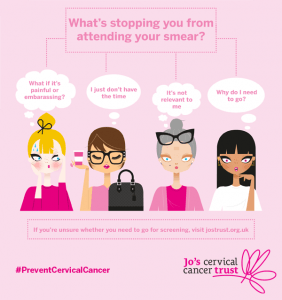When women are too busy for cervical screening or have had a bad experience, could HPV self-sampling be an appealing alternative?
By Laura Marlow, on 17 April 2018
By Kirsty Bennett and Laura Marlow
In the UK, women aged 25 to 64 are regularly invited for cervical screening (the ‘smear test’ or ‘Pap test’). While uptake of cervical screening is generally high, it has been declining in recent years, and in 2017 just over a quarter of women did not attend screening. Studies exploring screening non-attendance suggest a wide range of reasons that women do not go, including practical barriers such as difficulties arranging appointments, emotional barriers including embarrassment and fear of what the test might find and low perceived risk of cervical cancer.
One of our previous blogs described how most non-participants at screening are aware of screening and have made a decision about future attendance. The majority of these intend to go despite currently being overdue or unscreened, but some have made an active decision not to attend for screening in future. In our latest study, funded by Cancer Research UK as part of a larger project on cervical screening, we explored barriers to cervical screening among 426 women who had made an active decision not to attend in the future, and compared them with 117 women who intended to be screened in the future.
Participants were shown sixteen possible barriers which covered a variety of reasons why some women might not attend screening, and they were asked to choose the ones that applied to them. Women who had made an active decision not to be screened were more likely than the ‘intenders’ to say that screening wasn’t relevant to them because of their sexual behaviour (reported by 27%). Cervical cancer is caused by a sexually transmitted infection (HPV, or human papillomavirus – see below), so some women had decided not to go for screening because they were no longer sexually active, or had been in the same relationship for a long time. They also reported having more important things to worry about than screening (reported by 12%) and some said they had weighed up the risks and benefits and decided it was not worth getting screened (reported by 13%).
We went on to ask women about their interest in HPV self-sampling. HPV is a very common sexually transmitted infection and nearly all cases of cervical cancer are caused by this virus. It can take many years for an HPV infection to develop into cervical cancer so a woman’s current sexual behaviour does not necessarily reflect her current risk. Although it’s not offered by the NHS Cervical Screening Programme at the moment, HPV self-sampling allows women to collect a sample themselves, usually by using a vaginal swab. The sample is then sent to a laboratory and tested for HPV. Many of the women who had decided not to attend cervical screening (66%) indicated that they would be interested in self-sampling. Self-sampling seemed to be particularly appealing to women who reported a bad experience of screening in the past, and those who were too busy or embarrassed to attend. Shifting the perceived cost-benefit ratio for these women by offering HPV self-sampling might increase screening participation in this group. Studies in several countries have found that offering self-sampling to women who don’t attend for screening can be a very effective way of increasing participation. With the shift to HPV primary screening planned for 2019 in England, self-sampling may become a feasible option for some women.
Reference:
Kirsty F Bennett KF, Waller J, Chorley AJ, Ferrer RA, Haddrell JB, Marlow LAV. Barriers to cervical screening and interest in self-sampling among women who actively decline screening. Journal of Medical Screening. Published online.
 Close
Close


